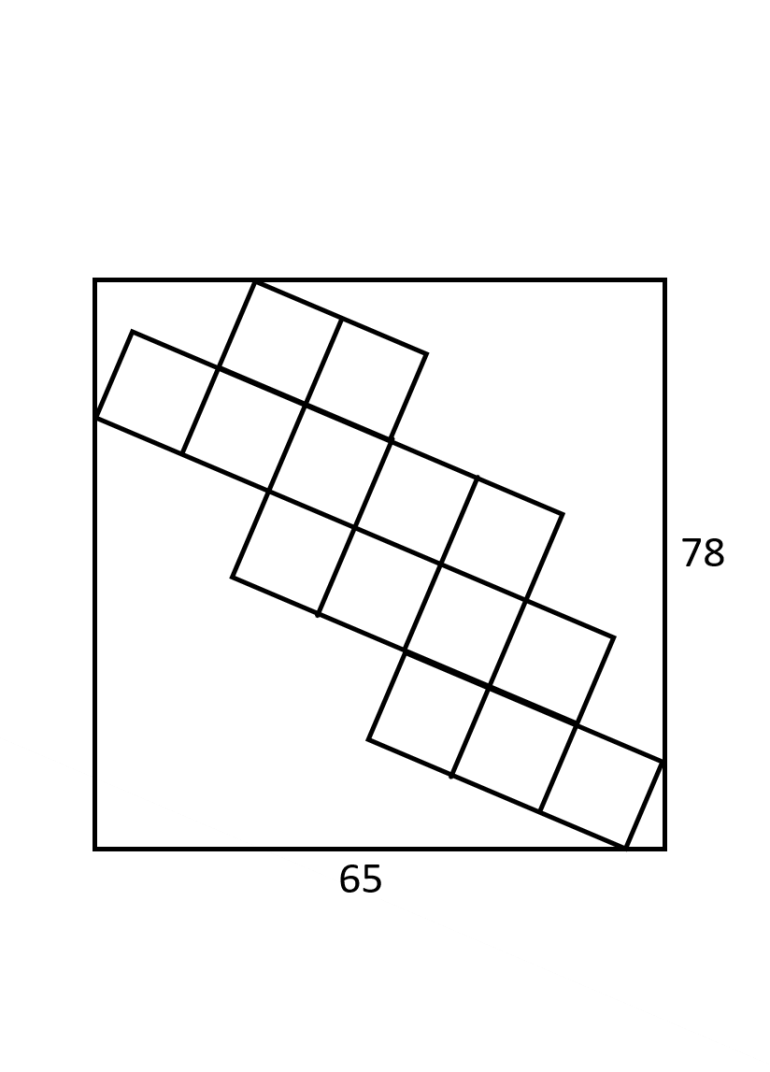Poll
 | 25 votes (49.01%) | ||
 | 16 votes (31.37%) | ||
 | 7 votes (13.72%) | ||
 | 4 votes (7.84%) | ||
 | 12 votes (23.52%) | ||
 | 3 votes (5.88%) | ||
 | 6 votes (11.76%) | ||
 | 5 votes (9.8%) | ||
 | 12 votes (23.52%) | ||
 | 10 votes (19.6%) |
51 members have voted
Quote: ThatDonGuy
To 100 places, I get:
0.14015 01597 77671 70675 03301 99764 58363 24852 96210 37282 37474 09380 11959 51720 40943 79197 71682 53488 94282 64038
link to original post
I agree.
I haven't checked anything but it shouldn't take long to knock up a similar spreadsheet.
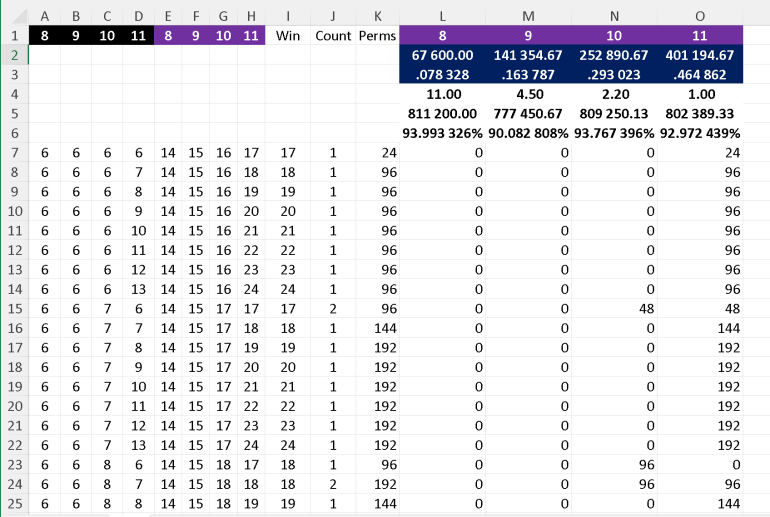
Quote: charliepatrickI've done a quick spreadsheet
link to original post
We're pretty close, but not quite in agreement. Probably something to do with the ties. My figures are the page I linked to.
Updated table.
| Winner | Pays | Probability | Return |
|---|---|---|---|
| 8 | 11 | 0.078328 | -0.060067 |
| 9 | 4.5 | 0.163787 | -0.099172 |
| 10 | 2.2 | 0.293023 | -0.062326 |
| 11 | 1 | 0.464862 | -0.070276 |
Quote: BleedingChipsSlowlyNo mention of ties?
link to original post
Once the game gets to a tie, it becomes a coin flip.

The U.S. debt is measured in trillions of dollars.
Could a New York Times reporter have written about this story one trillion seconds ago?
As seen from the surface of earth, the sun and the moon appear to be the same size. The sun is actually 400 times larger than the moon.
How far away from earth is the sun compared to how far away the moon is?
%2Fpic148345.jpg&f=1&ipt=c26ce95d0258ba6b7cadd6064529d544cc40f79af89e03c90b11d0cf575dcf24)
The board game Magic Realm has an unusual dice mechanic. Two standard six-sided dice are rolled, but only the higher of the two numbers acts as the result.
For example:
A 1-6 would = 6
A 3-4 would = 4
A 2-2 would = 2
What is the probability of getting a result of 5?
1. No. That comes to 31,710 years. I doubt there was a concept or term for numbers that big back then. Interesting thought.
2. If "size" is measured as volume, then I get 40^(1/3) =~ 7.368 times as far away.
3. 9/36 = 1/4.
Quote: Wizard
1. No. That comes to 31,710 years. I doubt there was a concept or term for numbers that big back then. Interesting thought.
2. If "size" is measured as volume, then I get 40^(1/3) =~ 7.368 times as far away.
3. 9/36 = 1/4.
link to original post
2. Not volume but diameter. (Think solar eclipse.)
Quote: GialmereHere are some belated Easy Monday puzzles...
link to original post
Time: there are 86,400 < 100,000 seconds per day, and 365.25 or so < 400 days per year, so there are < 40 million seconds per year, which means there are < 40 million x 25,000, or < 1 trillion, seconds in 25,000 years. Since the NYT was not around 25,000 years ago, it could not have reported on anything 1 trillion seconds ago.
Space: assuming the diameter of the sun is 400 times the diameter of the moon, it must be 400 times as far from Earth as the moon in order for the two to appear to be the same size. Think of the diameter of each as the far end of an isosceles triangle; you have two similar triangles.
Dice: of the 36 possible rolls of 2 dice, 11 of them (1-5 through 4-5, and 5-1 through 5-5) have the highest number 5, so the probability is 11/36.
Side note: you would think that, given how many games printed by the old Avalon Hill Game Company have been reprinted by other companies since its demise around 25 years ago, this one would have been reprinted at least once, but it has not.
Quote: Wizard
1. No. That comes to 31,710 years. I doubt there was a concept or term for numbers that big back then. Interesting thought.
2. If "size" is measured as volume, then I get 40^(1/3) =~ 7.368 times as far away.
3. 9/36 = 1/4.
link to original post
Quote: ThatDonGuy
Time: there are 86,400 < 100,000 seconds per day, and 365.25 or so < 400 days per year, so there are < 40 million seconds per year, which means there are < 40 million x 25,000, or < 1 trillion, seconds in 25,000 years. Since the NYT was not around 25,000 years ago, it could not have reported on anything 1 trillion seconds ago.
Space: assuming the diameter of the sun is 400 times the diameter of the moon, it must be 400 times as far from Earth as the moon in order for the two to appear to be the same size. Think of the diameter of each as the far end of an isosceles triangle; you have two similar triangles.
Dice: of the 36 possible rolls of 2 dice, 11 of them (1-5 through 4-5, and 5-1 through 5-5) have the highest number 5, so the probability is 11/36.
Side note: you would think that, given how many games printed by the old Avalon Hill Game Company have been reprinted by other companies since its demise around 25 years ago, this one would have been reprinted at least once, but it has not.
link to original post
Correct!
Good show.
Note that the moon is moving away from the earth at a rate of around 1.5 inches per year. Thus, on some future date, complete solar eclipses will no longer occur as the moon will be too far away to entirely block off the sun. On the other hand, a few billion years ago the moon would have appeared to be much larger than the sun, solar eclipses would have been wider ranging and also longer lasting.
Also, as mentioned, the game is no longer in print. Old copies in good condition can fetch $400 to $500 dollars at ebay.
----------------------------------------
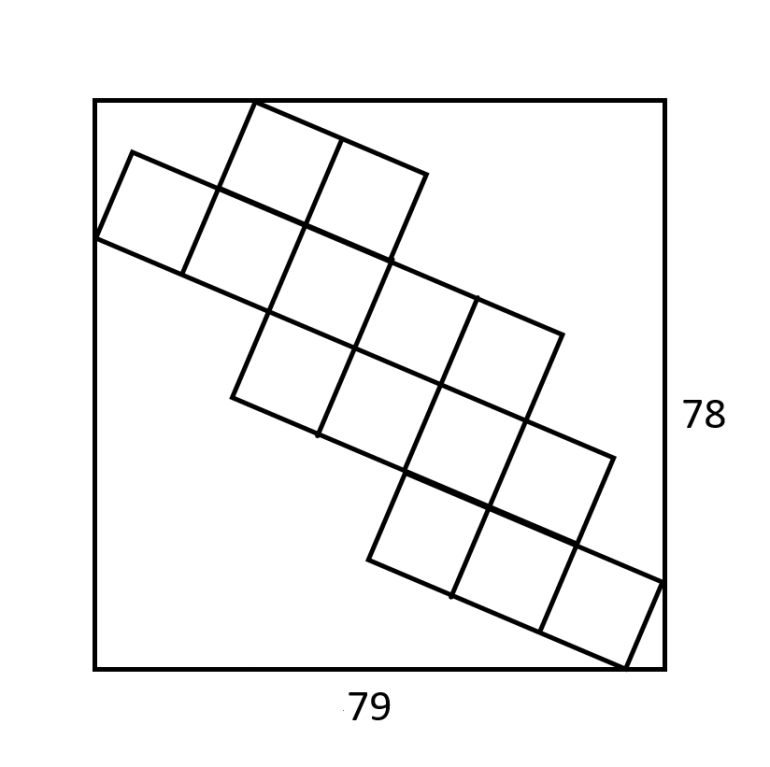
Update (4:15 PM 7/8/25): Horizontal length changed to 65.
Update (10:50 AM 7/9/25): Horizontal length changed to 79, vertical to 80.
Update (8:10 PM 7/9/25): Vertical length changed to 78.
The big rectangle has the dimensions indicated in the image above. The squares inside it are all equal in size. What is the length of the side of each square?
Fair warning that I found this one harder than it looks. Beer for the first correct solution.
Quote: Wizard
Update (4:15 PM 7/8/25): Horizontal length changed to 65.
The big rectangle has the dimensions indicated in the image above. The squares inside it are all equal in size. What is the length of the side of each square?
Fair warning that I found this one harder than it looks. Beer for the first correct solution.
link to original post
Using vector math, I get 13/23 times the square root of 445.
(If my answer is right, I'll show the work.)
Quote: ChesterDog
Using vector math, I get 13/23 times the square root of 445.
(If my answer is right, I'll show the work.)
link to original post
Maybe I'm the one in error, but I get something else. Did you note the changed width to 65?
Third opinion anyone?
Quote: WizardQuote: ChesterDog
Using vector math, I get 13/23 times the square root of 445.
(If my answer is right, I'll show the work.)
link to original post
Maybe I'm the one in error, but I get something else. Did you note the changed width to 65?
Third opinion anyone?
link to original post
I am still working on it
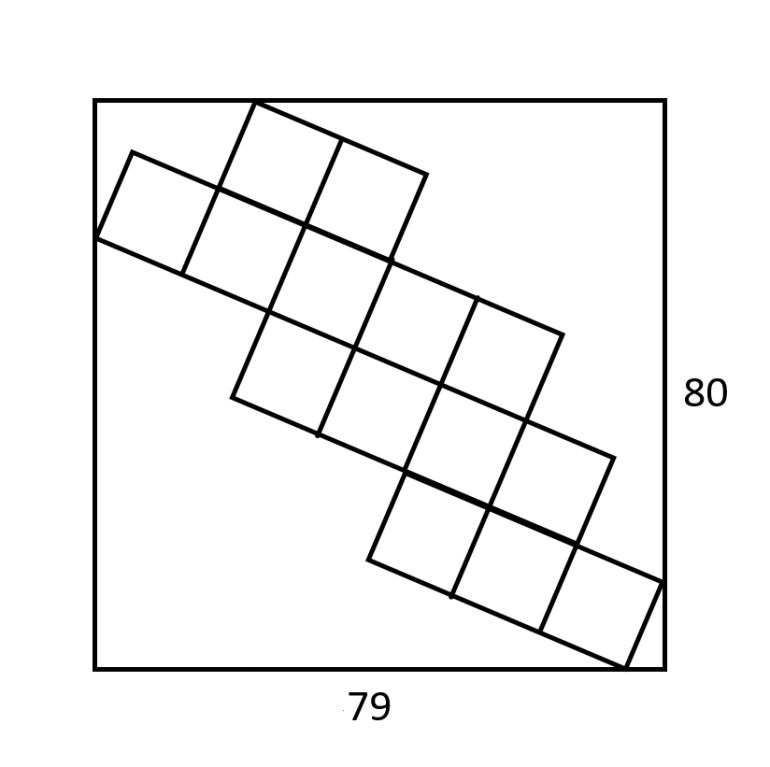
See diagram then solve the simultaneous equations, by adding up how many sides of triangles make the height and width.
80=6x+4y. 79=7y-x.
474=42y-6x. 554=46y.
y=277/23 x=122/23
Hence x^2+y^2 = (76729+14884)/(23*23) = 91613/(23*23).
Hence side of square is SQRT(91613)/23 which is about 13.1598.
It would have been nice if this had landed up as a whole number!
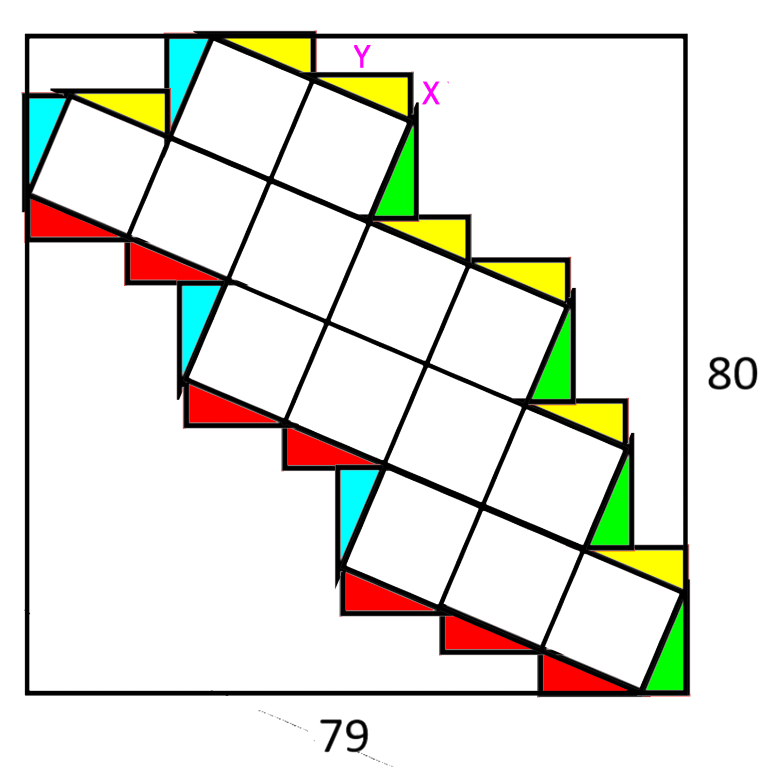
My apologies for three corrections.
Charlie earns more than a beer for this one.
1. Show that the trace of AB is the trace of BA where A and B are square matrices of the same size.
2. Prove that similar matrices have the same trace.
3. Develop a definition of the trace of a linear transformation T : V → V of a finite dimensional vector
space. Explain why it is well defined?
4. Describe the trace in terms of the characteristic polynomial of T and also in terms of the eigenvalues.
For this question, consider any Crash game.
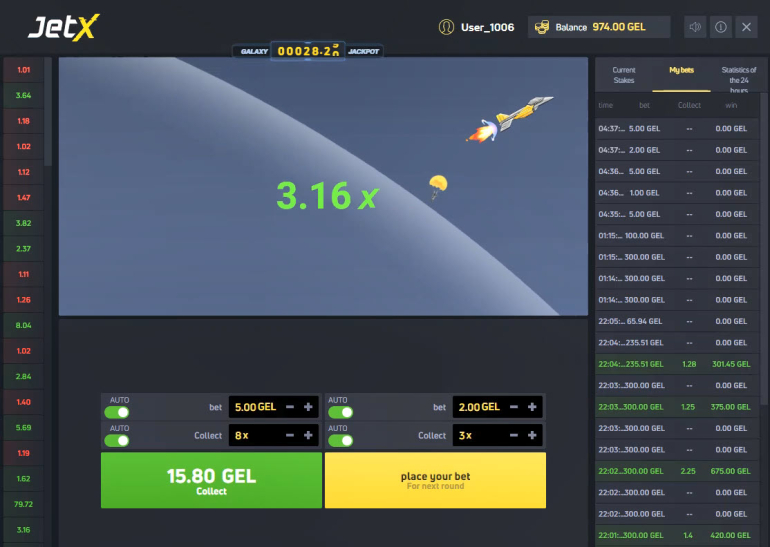
Briefly, this is a game where the player can cash out at any time. If he doesn't, his win grows exponentially. However, he can "crash" at anytime and lose.
For the same of this analysis, assume it is a fair bet whether to play on or not.
My questions are what are the mean and median levels the rocket will attain. Be careful to not solve for the time until crash, but the balance at the time of the crash.
Let say the chances of losing at the end of the current minute is 1/N. Then the fair price after the first minute is N/(N-1). The chances the rocket fails with the price at 1 is 1/N, so the contribution to the mean is 1/N.
After the second minute the fair price is now N2/((N-1)2) and the chances the rocket fails with the price at N/(N-1) is (N-1)/N*1/N; so the contribution to the mean is also 1/N.
Thus I think the mean is infinite and seems similar to tossing coins where the value doubles on a Head or loses on a Tail. There's a 1/4 chance of getting to 2 and losing (HT), there's a 1/8 chance of getting to 4 and losing (HHT)... etc. Each of these add 1/2 to the average, so the mean is infinite.
I suspect the median can be based on a poisson formula, and will depend on the chances the rocket crashes in any given time. For instance if the chance of losing each minute is 1/1000 it's about 693 minutes, when the price has got the 2. So you could work out x such that ((n+1)/n)x=2.
In this case, since it is a fair game, the game consists of selecting a uniform random number x in (0,1] and the crash value is 1/x.
Since x is uniform, the median value is where x = 1/2, so it is 2.
The mean is the area underneath the graph divided by the length of the domain; since the domain has length 1, it is INTEGRAL(0, 1) (1/x dx) = ln 1 - ln 0, which is positive infinity. Somehow, that doesn't make sense...
Quote: ThatDonGuy
In this case, since it is a fair game, the game consists of selecting a uniform random number x in (0,1] and the crash value is 1/x.
Since x is uniform, the median value is where x = 1/2, so it is 2.
The mean is the area underneath the graph divided by the length of the domain; since the domain has length 1, it is INTEGRAL(0, 1) (1/x dx) = ln 1 - ln 0, which is positive infinity. Somehow, that doesn't make sense...
link to original post
I agree. I also find it paradoxical that the mean can be infinity.
Another question could be if it takes one unit of time for the height to grow from 1 to 2, what is the mean time until the crash?
Quote: Ace2Wizardís crash webpage says the max payout is 1000. In that case the average payout would be about ln(1000) =~6.91
link to original post
For purposes of discussion, let's forget that rule. However, I can see the need for it, lest someone win more than the casino can pay.
1 / ln(2) =~ 1.44 unitsQuote: Wizard[
Another question could be if it takes one unit of time for the height to grow from 1 to 2, what is the mean time until the crash?
link to original post
Quote: Ace21 / ln(2) =~ 1.44 units
link to original post
Thanks. I believe I got the same thing.
There are seven treasure chests in a row. A pirate hides a treasure in one of them. Every night, he moves it to an adjacent chest. You may check one chest once a day, during the day. How you can you be assured of finding the chest beyond trial and error?
Quote: WizardThis puzzle is a classic.
There are seven treasure chests in a row. A pirate hides a treasure in one of them. Every night, he moves it to an adjacent chest. You may check one chest once a day, during the day. How you can you be assured of finding the chest beyond trial and error?
link to original post
Number the chests 1-7 in order
First, assume the treasure is in an even-numbered chest, which I will denote by:
_ 2 _ 4 _ 6 _
Search #2; if it is not there, then it shifts to an odd-numbered chest, but it cannot to go to 1:
_ _ 3 _ 5 _ 7
Search #3: if it is not there, then it shifts to an even-numbered chest, but it cannot go to 2:
_ _ _ 4 _ 6 _
Search #4: if it is not there, then it shifts to an odd-numbered chest, but it cannot go to 1 as it was not on 2, and it cannot go to 3 as it was not in 4:
_ _ _ _ 5 _ 7
Search #5, if it is not there, and the original assumption is correct, then the treasure is now in #6
Search #6
If the treasure is not there, then the original assumption was wrong, and the treasure was originally in an odd-numbered chest. However, since you have done five searches, the treasure is now in an even-numbered chest; repeat the process (i.e. search chests 2, 3, 4, 5, and 6 in order).
Quote: ThatDonGuy
Number the chests 1-7 in order
First, assume the treasure is in an even-numbered chest, which I will denote by:
_ 2 _ 4 _ 6 _
Search #2; if it is not there, then it shifts to an odd-numbered chest, but it cannot to go to 1:
_ _ 3 _ 5 _ 7
Search #3: if it is not there, then it shifts to an even-numbered chest, but it cannot go to 2:
_ _ _ 4 _ 6 _
Search #4: if it is not there, then it shifts to an odd-numbered chest, but it cannot go to 1 as it was not on 2, and it cannot go to 3 as it was not in 4:
_ _ _ _ 5 _ 7
Search #5, if it is not there, and the original assumption is correct, then the treasure is now in #6
Search #6
If the treasure is not there, then the original assumption was wrong, and the treasure was originally in an odd-numbered chest. However, since you have done five searches, the treasure is now in an even-numbered chest; repeat the process (i.e. search chests 2, 3, 4, 5, and 6 in order).
link to original post
I agree! Not only that, but I like the way you explain why it works. I had the same strategy, but my explanation was not as elegant.
Starting at t=1 minute, you roll a single six-sided die every minute until you roll a 4. So the sixth roll (if necessary) will occur at t=6 minutes.
What's the probability of receiving a new email before rolling a 4?
Quote: Ace2Your email account receives an average of one email every six minutes, following the exponential distribution. At t=0 minutes, you open your inbox and record the exact amount of time it takes to receive a new email
Starting at t=1 minute, you roll a single six-sided die every minute until you roll a 4. So the sixth roll (if necessary) will occur at t=6 minutes.
What's the probability of receiving a new email before rolling a 4?
link to original post
6(1-exp(-1/6)) =~ 0.92111
Solution available if I'm right.
Disagree. The chances should be about 50/50 since both events have an expected waiting time of six minutes.Quote: WizardQuote: Ace2Your email account receives an average of one email every six minutes, following the exponential distribution. At t=0 minutes, you open your inbox and record the exact amount of time it takes to receive a new email
Starting at t=1 minute, you roll a single six-sided die every minute until you roll a 4. So the sixth roll (if necessary) will occur at t=6 minutes.
What's the probability of receiving a new email before rolling a 4?
link to original post
6(1-exp(-1/6)) =~ 0.92111
Solution available if I'm right.
link to original post
This problem is comparable to the Russian roulette problems from a few months agoÖitís a fair matchup except for a timing difference
Quote: Ace2The chances should be about 50/50 since both events have an expected waiting time of six minutes.
link to original post
That was my first thought too. Then I went to sleep. Now that I'm awake...
The probability that we stop after n rolls is 5^(n-1)/6^n.
So we end up with the infinite sum where i goes from 1 to infinity of (5^(i-1)/6^i)(1-e^(-i/6)).
I think that's where the Wiz made his error; you can't just sum the first part and multiply by the 2nd part because the 2nd part isn't constant.
But I don't know how to sum this (at least I can't figure it out right now)
Given that the probability of getting an email within n minutes is 1-e^(-n/6):
The probability of getting an email in less than 1 minute is 1 - 1 / e^(-1/6); this is always before rolling a 4
The probability of getting the next email in 1-2 minutes is (1 - 1 / e^(-2/6)) - (1 - 1 / e^(-1/6)) = e^(-1/6) - e^(-2/6); there is 1 die roll, so the probability of not rolling a 4 is 5/6
For n > 1, the probability of getting the next email in between n and (n+1) minutes is e^(-n/6) - e^(-(n+1)/6), and there will be n die rolls, so the probability of not rolling a 4 before the email is (5/6)^n
The probability that the email occurs first is the sum of these:
1 - e^(-1/6) + 5/6 e^(-1/6) - 5/6 e^(-2/6) + (5/6)^2 e^(-2/6) - (5/6)^2 e^(-3/6) + (5/6)^3 e^(-3/6) - ...
= 1 - 1/6 e^(-1/6) - (1/6 x 5/6) (e^(-1/6))^2 - (1/6 x (5/6)^2) (e^(-1/6))^3 - (1/6 x (5/6)^3) (e^(-1/6))^4 - ...
= 1 - 1/6 e^(-1/6) (1 + 5/6 e^(-1/6) + (5/6)^2 e^(-1/6)^2 + (5/6)^3 e^(-1/6)^3 - ...)
= 1 - 1/6 e^(-1/6) / (1 - 5/6 e^(-1/6))
or about 0.52111
Quote: Ace2The chances should be about 50/50 since both events have an expected waiting time of six minutes.
link to original post
You're right.
(1-exp(-1/6))/(1-(5/6)exp(-1/6)) =~ 0.52111006
Quote: ThatDonGuy
Given that the probability of getting an email within n minutes is 1-e^(-n/6):
The probability of getting an email in less than 1 minute is 1 - 1 / e^(-1/6); this is always before rolling a 4
The probability of getting the next email in 1-2 minutes is (1 - 1 / e^(-2/6)) - (1 - 1 / e^(-1/6)) = e^(-1/6) - e^(-2/6); there is 1 die roll, so the probability of not rolling a 4 is 5/6
For n > 1, the probability of getting the next email in between n and (n+1) minutes is e^(-n/6) - e^(-(n+1)/6), and there will be n die rolls, so the probability of not rolling a 4 before the email is (5/6)^n
The probability that the email occurs first is the sum of these:
1 - e^(-1/6) + 5/6 e^(-1/6) - 5/6 e^(-2/6) + (5/6)^2 e^(-2/6) - (5/6)^2 e^(-3/6) + (5/6)^3 e^(-3/6) - ...
= 1 - 1/6 e^(-1/6) - (1/6 x 5/6) (e^(-1/6))^2 - (1/6 x (5/6)^2) (e^(-1/6))^3 - (1/6 x (5/6)^3) (e^(-1/6))^4 - ...
= 1 - 1/6 e^(-1/6) (1 + 5/6 e^(-1/6) + (5/6)^2 e^(-1/6)^2 + (5/6)^3 e^(-1/6)^3 - ...)
= 1 - 1/6 e^(-1/6) / (1 - 5/6 e^(-1/6))
or about 0.52111
link to original post
What am I missing? How do you get from the infinite sum in your 2nd last line to your final answer? I feel that I'm missing something really obvious but I don't see it.
(a) before rolling the dice an email may come in. Let the probability of that be x.
(b) when rolling the dice, the chance of rolling the desired number is 1/6 (this assumes weíve not seen an email yet)
(c) if neither of these happen then weíre back to the starting position.
So we just compare the chances of (a) with (b)|(not a).
Thus this is x compared to (1-x)/6.
So the chances of an email stopping the game is x/(x+(1-x)/6).
Quote: SkinnyTonyQuote: ThatDonGuy
The probability that the email occurs first is the sum of these:
1 - e^(-1/6) + 5/6 e^(-1/6) - 5/6 e^(-2/6) + (5/6)^2 e^(-2/6) - (5/6)^2 e^(-3/6) + (5/6)^3 e^(-3/6) - ...
= 1 - 1/6 e^(-1/6) - (1/6 x 5/6) (e^(-1/6))^2 - (1/6 x (5/6)^2) (e^(-1/6))^3 - (1/6 x (5/6)^3) (e^(-1/6))^4 - ...
= 1 - 1/6 e^(-1/6) (1 + 5/6 e^(-1/6) + (5/6)^2 e^(-1/6)^2 + (5/6)^3 e^(-1/6)^3 - ...)
= 1 - 1/6 e^(-1/6) / (1 - 5/6 e^(-1/6))
or about 0.52111
[/spoiler]
link to original post
What am I missing? How do you get from the infinite sum in your 2nd last line to your final answer? I feel that I'm missing something really obvious but I don't see it.
link to original post
For -1 < x < 1, the sum 1 + 1 / x + 1 / x^2 + 1 / x^3 + ... = 1 / (1 - x).
1 - 1/6 e^(-1/6) (1 + 5/6 e^(-1/6) + (5/6)^2 e^(-1/6)^2 + (5/6)^3 e^(-1/6)^3 - ...)
= 1 - 1/6 e^(-1/6) (1 + (5/6 e^(-1/6)) + (5/6 e^(-1/6))^2 + (5/6 e^(-1/6))^3 - ...)
= 1 - 1/6 e^(-1/6) (1 / (1 - 5/6 e^(-1/6))
= 1 - 1/6 e^(-1/6) / (1 - 5/6 e^(-1/6))
Note that if you replace 1 with (1 - 5/6 e^(-1/6)) / (1 - 5/6 e^(-1/6)), you get
(1 - 5/6 e^(-1/6)) / (1 - 5/6 e^(-1/6)) - 1/6 e^(-1/6) / (1 - 5/6 e^(-1/6))
= (1 - 5/6 e^(-1/6) - 1/6 e^(-1/6)) / (1 - 5/6 e^(-1/6))
= (1 - e^(-1/6)) / (1 - 5/6 e^(-1/6))
which is how Wizard expressed it.
showing queen. I don't understand why I shouldn't hit that 6. Running Count: +1 |
Decks Left: 4.23 | True Count: 0 No relative advantage based on 3 decks in
halfway through a shoe. Why does the trainer say hitting is a bad move? Because
the hand count has one face and 3 lows? Still the move is hit. Please explain.
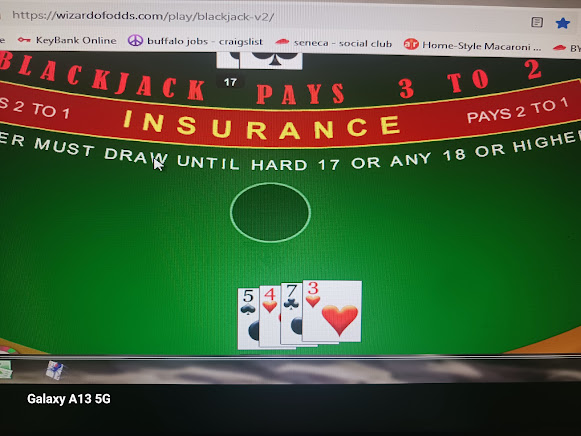
And know when to hold em. This is time to run to the cage:
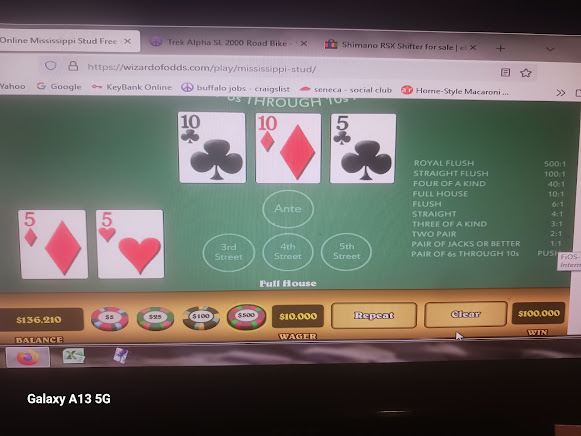
Sorry to interrupt the food or math guinness (genius in Cork) chatter. i don't know
what a spoiler tag is but the answer could be Mettalica one. Or one of those days
by the deceased Ozzy. His stock go up...
might have went on and taken basic actuarial math or statistics their freshman
year of college. After mastering AP calc in high school...
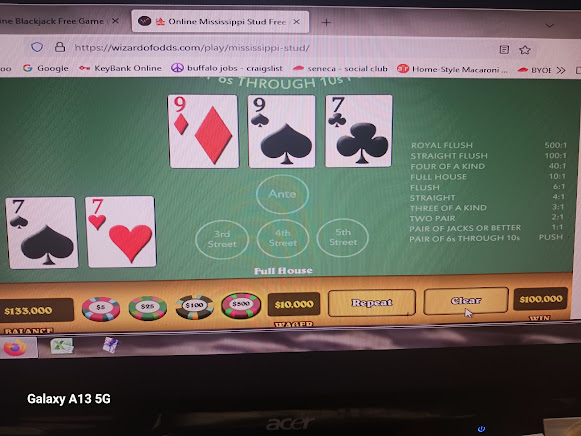
7s full is better the 5s full anyways
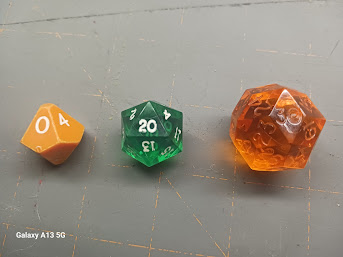
Agree! 🍺Quote: ThatDonGuy
Given that the probability of getting an email within n minutes is 1-e^(-n/6):
The probability of getting an email in less than 1 minute is 1 - 1 / e^(-1/6); this is always before rolling a 4
The probability of getting the next email in 1-2 minutes is (1 - 1 / e^(-2/6)) - (1 - 1 / e^(-1/6)) = e^(-1/6) - e^(-2/6); there is 1 die roll, so the probability of not rolling a 4 is 5/6
For n > 1, the probability of getting the next email in between n and (n+1) minutes is e^(-n/6) - e^(-(n+1)/6), and there will be n die rolls, so the probability of not rolling a 4 before the email is (5/6)^n
The probability that the email occurs first is the sum of these:
1 - e^(-1/6) + 5/6 e^(-1/6) - 5/6 e^(-2/6) + (5/6)^2 e^(-2/6) - (5/6)^2 e^(-3/6) + (5/6)^3 e^(-3/6) - ...
= 1 - 1/6 e^(-1/6) - (1/6 x 5/6) (e^(-1/6))^2 - (1/6 x (5/6)^2) (e^(-1/6))^3 - (1/6 x (5/6)^3) (e^(-1/6))^4 - ...
= 1 - 1/6 e^(-1/6) (1 + 5/6 e^(-1/6) + (5/6)^2 e^(-1/6)^2 + (5/6)^3 e^(-1/6)^3 - ...)
= 1 - 1/6 e^(-1/6) / (1 - 5/6 e^(-1/6))
or about 0.52111
link to original post
IMO this is the most efficient approachQuote: WizardHere is my solution, which does not involve any infinite series. Please forgive me for rewording the question a bit, but it still asks the same thing.
link to original post



